
Bhelpuri is a savoury snack originally from India, and is also a type of chaat. It is made of puffed rice, vegetables and a tangy tamarind sauce, and has a crunchy texture.

Bombay mix or chanachur is a Bangladeshi snack mix (namkeen) which consists of a variable mixture of spicy dried ingredients, such as sev, fried lentils, peanuts, chickpeas, chickpea flour ganthiya, corn, vegetable oil, puffed rice, fried onion and curry leaves. This is all flavored with salt and a blend of spices that may include coriander and mustard seeds.

Chaat, or chāt is a family of savoury snacks that originated in India, typically served as an hors d'oeuvre or at roadside tracks from stalls or food carts across South Asia in India, Pakistan, Nepal and Bangladesh. With its origins in Uttar Pradesh, India, chaat has become immensely popular in the rest of South Asia.
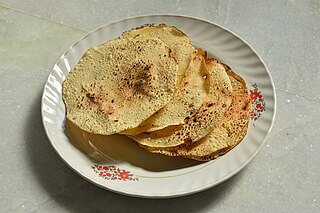
A papadam, also known as papad, is a snack that originated in the Indian subcontinent. Dough of black gram bean flour is either deep fried or cooked with dry heat until crunchy. Other flours made from lentils, chickpeas, rice, tapioca, millet or potato are also used. Papadam is typically served as an accompaniment to a meal in India, Pakistan, Bangladesh, Nepal, Sri Lanka and the Caribbean or as an appetizer, often with a dip such as chutneys, or toppings such as chopped onions and chili peppers, or it may be used as an ingredient in curries.

Rajasthani cuisine is the cuisine of the Rajasthan state in North West India. It was influenced by various factors like the warlike lifestyles of its inhabitants, the availability of ingredients in an arid region and by Hindu temple traditions of sampradayas like Pushtimarg and Ramanandi. Food that could last for several days and could be eaten without heating was preferred. Scarcity of water and fresh green vegetables have all had their effect on the cooking. Signature Rajasthani dishes include Dal Baati Churma, Panchratna Dal, Papad ro Saag, Ker Sangri, Gatte ro Saag. It is also known for its snacks like Bikaneri bhujia, Mirchi bada and Kanda kachauri. Other famous dishes include Dal Baati, malaidar special lassi (lassi) and Lashun ki chutney, Mawa lassi from Jodhpur, Alwar ka mawa, Malpauas from Pushkar and rasgulla from Bikaner, "paniya"and "gheriya" from Mewar. Originating for the Marwar region of the state is the concept Marwari Bhojnalaya, or vegetarian restaurants, today found in many parts of India, which offer vegetarian food of the Marwari people. The history also has its effect on the diet as the Rajputs preferred majorly a non-vegetarian diet while the Brahmins, Jains, Bishnois and others preferred a vegetarian diet. So, the state has a myriad of both types of delicacies.

Puffed rice and popped rice are types of puffed grain made from rice commonly eaten in the traditional cuisines of Southeast Asia, East Asia, and South Asia. It has also been produced commercially in the West since 1904 and is popular in breakfast cereals and other snack foods.
Maharashtrian or Marathicuisine is the cuisine of the Marathi people from the Indian state of Maharashtra. It has distinctive attributes, while sharing much with other Indian cuisines. Traditionally, Maharashtrians have considered their food to be more austere than others.
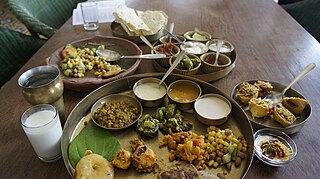
Gujarati cuisine is the cuisine of the Indian state of Gujarat. The typical Gujarati thali consists of rotli, dal or curry, rice, and shaak. The thali will also include preparations made from pulses or whole beans such as moong, black eyed beans etc., a snack item (farsaan) like dhokla, pathra, samosa, fafda, etc. and a sweet (mishthaan) like mohanthal, jalebi, sevaiya etc.

Dahi puri is an Indian snack food which is especially popular in the state of Maharashtra. The dish is a type of chaat and originates from the city of Mumbai. It is served with mini-puri shells (golgappa), which are also used for the dish pani puri. Dahi puri and pani puri chaats are often sold by the same vendor.

Kachori is a sweet and spicy deep-fried snack, originating in India, and common in places with Indian diaspora and other South Asian diaspora. Alternative names for the snack include kachauri, kochuri, kachodi and katchuri.

Poha, also known as pohe, pauwa, sira, chira, chivda, avil or avalakki, among many other names, is flattened rice originating from the Indian subcontinent. Rice is parboiled before flattening so that it can be consumed with very little to no cooking. These flakes of rice swell when added to liquid, whether hot or cold, as they absorb water, milk or any other liquids. The thickness of the flakes varies from almost translucently thin to nearly four times thinner than a normal rice grain.
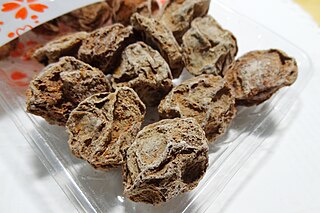
Li hing mui, known as huamei in Mainland China, is salty dried Chinese plum. It has a strong, distinctive flavor and is often said to be an acquired taste, as it has a combination of sweet, sour, and salty taste. Originally from Guangdong Province, the name "li hing mui" means "traveling plum". "Li hing" is "traveling" and "mui" is "plum" in Cantonese. Li hung mui is called hoshiume in Japan, where the salty and sour umeboshi is also popular. Li hing mui, along with li hing powder, is extremely popular as a snack in Hawaii.

Misal, is a very popular spicy dish in the Western Indian state of Maharashtra. The dish is mostly eaten for breakfast or as a midday snack or sometimes as a one-dish meal, often as part of misal pav. It remains a favourite snack since it is easy to make with affordable ingredients and has a good nutritional value. The taste of misal ranges from mildly to extremely spicy. And there are a lot of varieties as well. Misal is also a popular traditional food of Maharashtra. The dish is always served hot.

Malaysian Indian cuisine, or the cooking of the ethnic Indian communities in Malaysia, consists of adaptations of authentic dishes from India, as well as original creations inspired by the diverse food culture of Malaysia. Because the vast majority of Malaysia's Indian community are of South Indian descent, and are mostly ethnic Tamils who are descendants of immigrants from a historical region which consists of the modern Indian state of Tamil Nadu and Sri Lanka's Northern Province, much of Malaysian Indian cuisine is predominantly South Indian inspired in character and taste. A typical Malaysian Indian dish is likely to be redolent with curry leaves, whole and powdered spice, and contains fresh coconut in various forms. Ghee is still widely used for cooking, although vegetable oils and refined palm oils are now commonplace in home kitchens. Before a meal it is customary to wash hands as cutlery is often not used while eating, with the exception of a serving spoon for each respective dish.
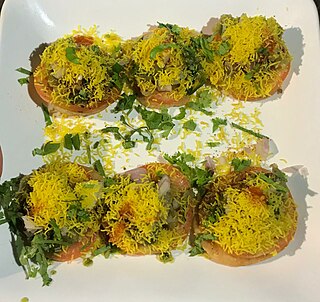
Sev puri is an Indian snack and a type of chaat. It is a speciality that originates from Mumbai, Maharashtra, India. In Pune and Mumbai, sev puri is strongly associated with street food, but is also served at upscale locations. Recently, supermarkets have started stocking ready-to-eat packets of sev puri and similar snacks like bhelpuri.

Sev is a popular Indian snack food consisting of small pieces of crunchy noodles made from chickpea flour paste, which are seasoned with turmeric, cayenne, and ajwain before being deep-fried in oil. These noodles vary in thickness. Ready-to-eat varieties of sev, including flavoured sev, are available in Indian stores.
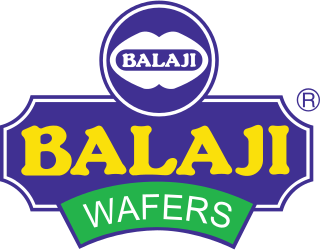
Balaji Wafers is one of the largest snack food manufacturer and distributor in India. Founded in 1974, it produces and distributes a variety of potato chips and other grain-based snack foods.

Masala puri, or Masalpuri, is an Indian snack which is especially popular in the southern state of Karnataka. A form of chaat, the dish originated in the Indian state of Karnataka and has now become famous in the entire Indian subcontinent. Typically spicy, the dish can also be made sweet based on the requirement.

Kripik or keripik are Indonesian chips or crisps, bite-size snack crackers that can be savoury or sweet. They are made from various dried fruits, tubers, vegetables, and fish that have undergone a deep frying process in hot vegetable oil. They can be lightly seasoned with salt, or spiced with chili powder and sugar.


















